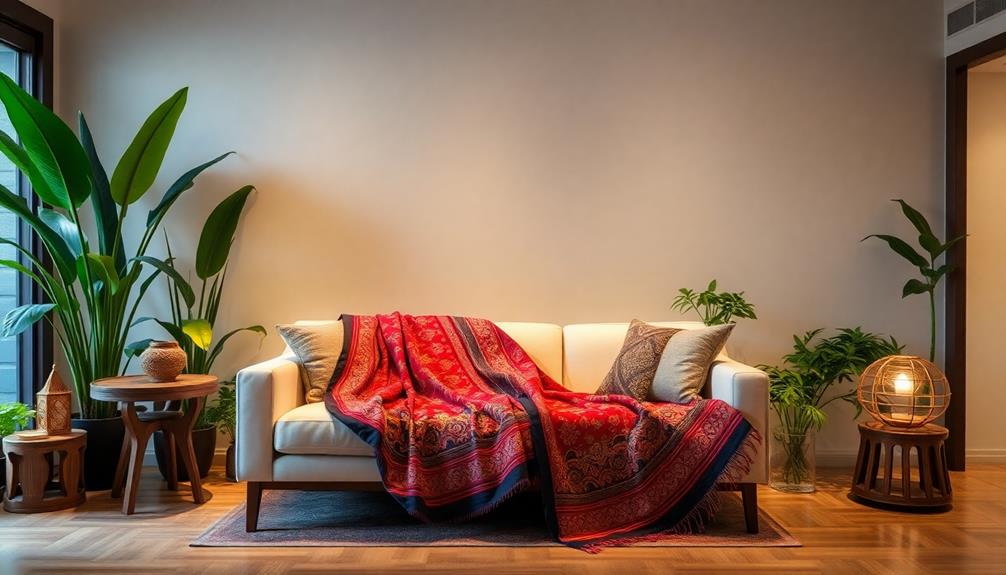You can easily reveal the beauty of batik in your home design by incorporating its vibrant patterns and cultural significance. Use batik throw pillows to add a pop of color or opt for wall art that showcases its intricate designs. Batik table runners bring elegance to your dining space, while lampshades crafted from batik fabric can create a warm ambiance. Mix batik pieces with neutral tones for a balanced look. This timeless textile not only enhances aesthetic appeal but also carries rich stories. Discover more ways to integrate batik into your decor and celebrate this unique artistry.
Key Takeaways
- Incorporate batik through decorative throw pillows and table runners to add cultural richness and visual interest to your home decor.
- Use framed batik fabric as wall art to create striking focal points that celebrate Indonesian heritage.
- Choose large batik statement pieces to showcase intricate patterns and vibrant colors in your living space.
- Balance batik patterns with neutral tones to maintain elegance and avoid overwhelming the decor.
- Explore local workshops to learn batik techniques, enhancing your appreciation and ability to incorporate this art form into your design.
What Is Batik?

Batik is a fascinating textile art form that hails from Indonesia, known for its unique wax-resist dyeing technique. This traditional textile method involves applying hot wax to fabric before dyeing, creating intricate patterns that showcase the artistry and cultural significance of Indonesian culture.
The term "batik" comes from the Javanese word "bathikan," meaning to draw or mark, reflecting the meticulous process behind each piece. Much like the intricate designs of Indonesian decor masks, batik captures the essence of cultural storytelling through its vivid patterns and colors.
Batik can be categorized into various styles, with Batik Tulis being hand-drawn, Batik Cap stamped, and Batik Lukis painted. Each style exhibits its own unique aesthetic qualities and production methods, highlighting the craftsmanship involved.
The vibrant colors and detailed designs make batik a versatile choice for home decor, allowing you to add a touch of artistic flair to your space.
Beyond its beauty, batik holds significant cultural value, with specific motifs conveying social status and heritage. Incorporating batik into your home not only enhances its visual appeal but also pays homage to this rich tradition, fostering a connection to the depths of Indonesian culture while celebrating the intricate artistry of this beloved textile.
History and Cultural Significance

Batik's origins trace back centuries, rooted deeply in Indonesian culture. Each pattern carries its own symbolism, often reflecting social status and heritage, while regional variations showcase the diverse artistry across different areas.
The intricate motifs and vibrant colors of batik not only enhance the aesthetic appeal of spaces but also serve as a celebration of Indonesian decorative pillows that can bring comfort and cultural heritage into your home.
Understanding these elements will enrich your appreciation for batik as a unique aspect of home design.
Origins of Batik
The art of batik has a rich history that spans continents, with its roots traced back to ancient practices in places like Sri Lanka and Africa. Derived from the Indonesian word meaning "to dot" or "wax writing," batik flourished particularly in Java, Indonesia, where unique patterns and styles emerged. This evolved technique of wax-resist dyeing became a significant part of Indonesian culture and was recognized by UNESCO as a Masterpiece of Oral and Intangible Heritage.
Batik motifs aren't just decorative; they convey social status and cultural significance. Specific patterns, like parang and truntum, were traditionally reserved for royalty and ceremonial occasions. Understanding these historical roots allows you to appreciate the depth of the art form.
| Aspect | Details | Significance |
|---|---|---|
| Origins | Ancient practices in Sri Lanka and Africa | Cross-cultural influence |
| Unique Patterns | Developed in Java, Indonesia | Reflects regional identity |
| Social Status | Certain motifs for royalty | Indicates hierarchy |
| Cultural Significance | Shared practices and storytelling | Preserves heritage |
| Recognition | UNESCO designation | Global acknowledgment |
As you explore batik, you'll find a tapestry of history woven into each piece.
Symbolism in Patterns
Many batik patterns hold deep symbolism, reflecting the social status and cultural values of the communities that create them. In Indonesian tradition, specific batik motifs, like parang and truntum, are reserved for royal families and weddings, showcasing their importance in society.
Additionally, the craftsmanship involved in designing batik is reminiscent of traditional artistry in Indonesian decor masks, where each piece tells a story unique to its region. These unique designs not only beautify fabrics but also serve as a storytelling medium, encapsulating personal narratives and heritage.
The colors used in batik are just as significant; dark red and indigo blue often symbolize strength and dignity, adding layers of meaning to each piece. As you explore batik for your home design, consider how these elements resonate with you. Each motif you choose can tell a story that connects you to Indonesian culture, enriching your living space.
UNESCO's recognition of batik as a Masterpiece of Oral and Intangible Heritage underscores its cultural importance and the need to preserve traditional techniques.
Regional Variations and Styles
In exploring batik, you'll discover a rich tapestry of regional variations and styles that showcase Indonesia's diverse cultural heritage. Batik cloth, especially from Java, features distinct batik designs that reflect the unique motifs of each region. For instance, the parang and truntum motifs are often reserved for royalty and ceremonial occasions, highlighting their cultural significance.
Additionally, traditional Indonesian housing, known as "Rumah Adat," often incorporates similar cultural symbolism, showcasing the importance of heritage in both textiles and architecture. This connection emphasizes how housing reflects social status and regional identity.
When you look at Malaysian batik, you'll notice larger floral and geometric motifs created using brush painting techniques. This style illustrates the local culture's artistic influences and preferences.
On the other hand, Peranakan batik, which originates from the Straits Chinese culture, showcases intricate designs like cranes and lotus flowers in elegant pastel colors.
Each of these styles conveys deeper meanings, often linked to social status and the celebration of nature. The motifs you choose can serve as a medium for storytelling, preserving cultural narratives, and honoring traditions.
As you incorporate batik into your home design, you'll not only enhance your aesthetic but also embrace the rich history and cultural significance that these beautiful fabrics represent.
Types of Batik

When exploring the types of batik, you'll find each style offers unique characteristics and techniques.
In addition to their visual appeal, these batik designs often tell rich stories and reflect local culture, similar to the importance of Indonesian decor masks.
Batik Tulis showcases intricate hand-drawn designs, while Batik Cap uses stamps for quicker production.
Plus, modern innovations like Batik Lukis allow for creative expression that pushes traditional boundaries.
Batik Tulis Characteristics
Batik Tulis stands out among batik types due to its hand-drawn designs created with a canting tool, making every piece unique and often more intricate. This labor-intensive method not only showcases the artisanal quality of the fabric but also reflects deep cultural significance.
The use of natural materials and earthy tones in Batik Tulis can complement the calming aesthetic of Balinese design characteristics, creating a harmonious environment within your home.
Here are three key characteristics of Batik Tulis:
- Cultural Themes: The patterns often depict nature and social status, telling stories deeply rooted in tradition.
- Ceremonial Occasions: Certain designs are reserved for special events, highlighting their importance in cultural rituals.
- Natural Dyes: The rich, earthy tones derived from natural dyes enhance the beauty and depth of each piece.
Each Batik Tulis piece can take several days to complete, a reflection of the skill and dedication of the artisan. The use of the canting tool allows for precision in the hand-drawn designs, making every fabric a one-of-a-kind masterpiece.
Batik Cap Techniques
While Batik Tulis showcases the intricate artistry of hand-drawn designs, Batik Cap offers a distinct approach through its efficient stamping technique. This method, known as stamped batik, uses a copper stamp called a canting cap to apply wax patterns quickly and uniformly across fabric. This efficiency allows for larger quantities of batik fabric to be produced while maintaining consistent designs, making it ideal for commercial use.
Batik Cap reflects Indonesia's artistic traditions and is recognized by UNESCO as important cultural heritage. It typically features more uniform designs compared to the intricate variations of Batik Tulis, appealing to a broader audience for diverse applications in fashion and decor. Despite being less time-consuming, each stamped piece can still exhibit unique characteristics based on the application process.
Here's a quick comparison of Batik Cap and Batik Tulis:
| Feature | Batik Cap |
|---|---|
| Application Method | Stamped wax patterns |
| Efficiency | High |
| Design Variability | More uniform |
| Ideal Use | Commercial & home design |
Incorporating Batik Cap into your home design adds a touch of Indonesian culture that blends tradition with modern aesthetics.
Modern Batik Innovations
In recent years, innovations in batik have taken traditional techniques and infused them with contemporary creativity, resulting in a diverse range of styles.
The beauty of these designs can be enhanced further by incorporating elements of traditional Indonesian style home decor, which emphasizes natural materials and intricate patterns.
You can explore these modern batik innovations that enhance your home design:
- Batik Tulis: Featuring hand-drawn, intricate designs created with a canting tool, this form showcases meticulous craftsmanship, making each piece unique and valuable.
- Batik Cap: Utilizing copper stamps for uniform designs, this method allows for faster production while maintaining artistic integrity, recognized by UNESCO for its cultural significance.
- Batik Lukis: This technique involves painting directly on fabric, offering a modern twist and flexibility for artistic expression that breaks away from traditional patterns.
You'll also notice Batik Pesisir, known for its vibrant colors and relaxed techniques, and Batik Belanda, which fuses Western elements with Javanese tradition.
These innovations not only celebrate the rich heritage of batik but also bring fresh, eye-catching designs into your space, making it a perfect blend of cultural beauty and modern flair.
Embrace these diverse batik designs to truly reveal the beauty of batik in your home!
Modern Applications of Batik

With its vibrant colors and intricate patterns, batik has found a fresh place in modern home design. Designers like Chitra Subyaktos and Bateeq are breathing new life into traditional patterns, making them accessible to a broader audience. You can easily incorporate batik into your space through various modern applications, whether it's using batik-inspired fabrics for curtains or adding unique throws and cushions to your living room.
Additionally, incorporating elements from luxury tropical design aesthetics can further enhance the overall look and feel of your interior.
Batik serves as a stunning focal point in interior design when showcased through wall-mounted art displays, highlighting its rich artistic heritage and handmade textiles. The versatility of batik allows it to enhance both small urban apartments and spacious vacation homes, making it a perfect choice for any setting.
Additionally, the growing interest in sustainable fashion has increased appreciation for handmade batik, leading to more workshops and educational programs that promote these traditional skills.
This revival not only preserves the craft but also encourages unique interpretations that resonate with contemporary aesthetics. By embracing batik in your home design, you celebrate both its cultural significance and its modern appeal, creating a space that's vibrant and meaningful.
Incorporating Batik in Home Decor

Batik brings a unique flair to home decor, effortlessly blending tradition with modernity. Its rich patterns can evoke the essence of Indonesian culture, making it a perfect choice for those looking to enhance their living spaces with a touch of heritage.
Incorporating batik fabric into your space can transform it in stunning ways. Here are three ideas to get you started:
- Decorative Throw Pillows: Use batik fabric for throw pillows to instantly elevate the visual interest in your living room or bedroom. You can easily swap covers seasonally for a fresh look. Consider using traditional motifs and patterns that reflect cultural significance.
- Table Runners: Add batik table runners to your dining table for a unique blend of elegance and cultural significance, perfect for both casual meals and formal gatherings.
- Wall Art: Frame pieces of batik fabric as wall art to create striking focal points or design a gallery wall that showcases various batik designs.
Additionally, consider DIY lampshades or window treatments using batik fabric to introduce warmth and personality into your rooms.
These accent pieces not only showcase the art form but also serve functional purposes. By incorporating batik into your home decor, you'll create a space that reflects your style while celebrating this beautiful cultural heritage.
Design Tips for Batik Use

When it comes to elevating your home decor, thoughtful design tips can make all the difference in how you use batik. Start by incorporating batik as a statement piece through large wall hangings that showcase its intricate patterns and vibrant colors. This draws attention while setting the tone for your space.
To maintain elegance, balance the boldness of batik with neutral tones and crisp elements in your design, preventing a cluttered look. Emphasizing the beauty of handcrafted items, which are prevalent in Southeast Asia Decor, can further enhance your home's aesthetic.
For dining areas, batik table runners or placemats offer an elegant touch. Mix and match different designs to create visual interest while celebrating cultural artistry.
In your living room or bedroom, batik cushions and pillows can be sewn in various shapes and sizes, adding dynamic textures and color.
Don't forget about lighting! Consider batik-covered lampshades or DIY curtains to enhance your home's overall aesthetic. These decorative methods not only introduce unique elements but also infuse warmth and personality into your space.
Resources for Batik Enthusiasts

For those passionate about batik, a wealth of resources awaits to enrich your understanding and appreciation of this vibrant art form. Here are three essential resources to evaluate:
- Books: "Batik, Traditional Textiles of Indonesia" offers insights into various batik styles and their cultural significance, making it a must-read for enthusiasts.
- Online Shops: Websites like Betterthanblouses provide comfortable batik clothing options adorned with unique batik designs, ensuring you can effortlessly incorporate this art into your daily wardrobe.
- Workshops: Participating in batik-making workshops deepens your understanding of the techniques and artistry involved, allowing you to connect with local artisans and appreciate the craft on a personal level.
Additionally, films like "Batik Girl" explore the emotional connection between art and culture, emphasizing batik's role in storytelling.
With numerous shops and online resources available, discovering traditional textiles and supporting local artisans has never been easier.
Frequently Asked Questions
What Does Batik Symbolize?
Batik symbolizes cultural identity and heritage, conveying social status and virtues through its intricate patterns. Each design tells a story, reflecting community values and fostering connections among artisans who preserve this beautiful traditional art form together.
What Is the Batik Method of Design?
Did you know batik's a fascinating art form? You're applying hot wax to fabric, creating intricate patterns while preventing dye from seeping in. It's a blend of tradition and creativity that results in stunning designs.
What Are the 5 Major Types of Batik Design?
The five major types of batik design are Batik Tulis, Batik Cap, Batik Lukis, Batik Pesisir, and Batik Belanda. Each type showcases unique techniques and cultural influences, offering a rich tapestry of artistic expression.
How to Batik at Home?
If you're ready for a delightful adventure, gather your tools, warm your canting, and start applying wax to fabric. Mix your dyes, layer them carefully, and watch your creativity unfold as you batik at home!
Conclusion
Incorporating batik into your home design not only adds vibrant color and unique patterns but also connects you to a rich cultural history. Imagine transforming a simple living room with a stunning batik throw pillow that sparks conversation and admiration. By thoughtfully choosing batik textiles and decor, you can create a space that reflects your personality while celebrating this art form. Embrace batik, and let it reveal a new level of beauty in your home!










